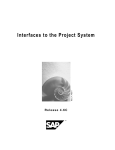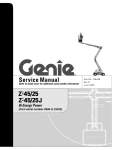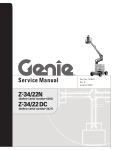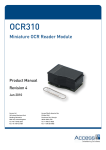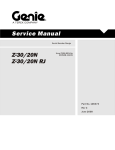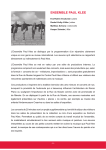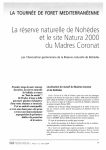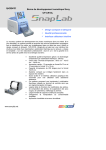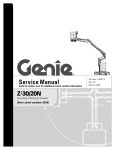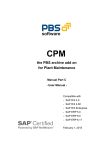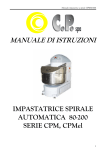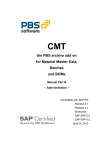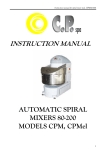Download PBS archive add on CPM - Manual Part B
Transcript
CPM the PBS archive add on for Plant Maintenance Manual Part B - Administration - Compatible with - SAP R/3 4.0 - SAP R/3 4.6C - SAP R/3 Enterprise - SAP ERP 5.0 - SAP ERP 6.0 - SAP ERP 6.17 February 1, 2015 PBS archive add on CPM - Administration - © 1999 - 2015 PBS Software GmbH Schwanheimer Strasse 144a 64625 Bensheim, Germany Phone: +49 - 6251 - 174 0 Fax: +49 - 6251 - 174 174 email: [email protected] Internet: www.pbs-software.com ® PBS archive add ons is a registered trademark of PBS Software GmbH, Bensheim. SAP, R/3, SAP ERP, SAP NetWeaver, ABAP and others are registered trademarks of SAP SE, Walldorf/Baden. Acrobat Reader is a registered trademark of Adobe Systems Incorporated. 2 PBS archive add on CPM - Administration - Introduction to the PBS ILM Concept Information Lifecycle Management Information Lifecycle Management (ILM) means the administration of information related to the time when it is used, taking into account its total costs and compliance. A conclusive, efficient ILM concept must, as a result, control data growth, manage retention rules, and also ensure compliant data storage. Furthermore, an easy access to archived data is decisive and, for example, its transfer during internal and external audits. PBS ILM Concept PBS software provides existing SAP customers extensive solutions to put into practice the requirements that were described above for a stringent and successful ILM concept. PBS is considered as an expert for complex, integrated data accesses to archived and database data and meanwhile, also to data that is located on decommissioned SAP systems. In addition to classical SAP data archiving, SAP BI-specific nearline storage is also supported. PBS archive add ons® PBS archive add ons always rely on SAP archiving having been carried out successfully. This is the basis for a permanently high-performing SAP system. In principle, you can indeed retain posted documents in the SAP database for a very long time due to a large database capacity. Depending on the document volume, this may result, however, in massive performance losses and, sooner or later, heavily increasing operation costs. The daily backup becomes difficult for large data stocks, for example. A convenient display and evaluation of archived transaction data – as the SAP user is used to for database data – can often only be carried out in a very restricted manner using SAP standard means depending on the application module. This is particularly the case for large archive data stocks. The PBS archive add ons can be used here. They can be provided for nearly all SAP modules and release levels, and start with a "C" (for Complete) in their description. For example, PBS archive add on CCOPA for the SAP module COPA. Using the PBS archive add ons you can quickly and easily access your archived data even after data archiving during your day-to-day business. The unrestricted data access is realized by an intelligent indexing concept. It extends the SAP archive infrastructure components and integrates itself optimally with SAP archiving. Archive data that has been indexed can still be provided after a release upgrade immediately, without restrictions, and without migration effort. The PBS archive index is stored in sequential files of the SAP file system in the same way as the SAP archive data. Afterwards, you can access the archive data online via the familiar transactions. The SAP user can display the data from the SAP database and the 3 PBS archive add on CPM - Administration - archive data simultaneously via the PBS archive add on index. For the user, it seems as though the archived data is still in the SAP database. The deep integration of the PBS transactions also enables direct navigation to subsequent and previous documents both within the indexed SAP module as well as to linked documents from other SAP modules. This applies not only for resident but also without restrictions for archived data. The benefit for the user increases the more PBS archive add ons are used. The potential benefits of the ILM concept raises substantially if you take into account the savings that result from the SAP mirror systems. There are usually at least two of them meaning that the saved disk storage can be tripled by performing data archiving. Thus, time is saved for the data backup. 4 PBS archive add on CPM - Administration - 5 Table of Contents 1. Introduction 6 2. Overview on the PBS archive add on CPM 7 2.1. Object Names for SAP Releases up to 3.1 7 2.2. Supplied Menus 8 2.3. Basic Information on the PBS archive add on CPM 9 2.4. Archiving of PM_EQUI and PM_OBJLIST 3. 4. 12 2.4.1 Special Features for PM_EQUI 13 2.4.2 Special Features for PM_OBJLIST 15 Construction of the PBS archive add on CPM 18 3.1. Procedure 18 3.2. The PBS load programs 19 3.3. Initial Load Process 22 3.4. Loading the Administration Table 25 3.5. Further Load Processes 26 3.6. Delete PBS Archive Index 27 3.7. PBS Archive Tool 28 3.8. Summary of the PBS Archive Construction 30 3.9. The Administration Board (from SAP Release 5.0) 31 3.10. Directory, Requirement of Disk Space and Run Times 32 3.11. Definition of the Path to the PBS archive add on CPM 33 Transactions of the PBS archive add on CPM 34 PBS archive add on CPM - Administration - 1. Introduction The PBS archive add ons are constructed in modular form and cover the application modules FI, SD, MM, CO etc. with a special program package for exactly this application. You can easily see from the name which PBS archive add on belongs to which SAP module: CFI, CSD, CMM, CCO etc. All PBS archive add ons have in common that they can be easily installed in the SAP R/3 system via the SAP transport utilities "tp" and “SAINT”. For installation details of the PBS archive add ons please see the specific installation manual (manual part A). This administration manual was written to make construction and administration of the PBS archive add on CPM as easy as possible. At first, data archiving with transaction SARA is discussed; the second topic is the PBS index construction from the SAP archive files. The modular user manual of each PBS archive add on is composed of partial manuals: - Part A: Installation - Part B: Administration, Archive Construction and Maintenance - Part C: Application Programs / Transactions - Part D: Migration Support R/2 => R/3 (if available) There are additional manuals for the PBS utilities: Conversion Tool, Archive Browser, Translation Tool. Should you have questions regarding the installation of the PBS archive add ons or if you have problems when installing the software please call directly the Service Hotline of PBS Software GmbH: Phone: +49 - 6251 - 174 110 Fax: +49 - 6251 - 174 174 email: [email protected] Release Compatibility The PBS archive add on CPM discussed in this manual runs with the basis programs of SAP SE, D-69190 Walldorf/Baden, R/3 system, releases 4.0, 4.6C, Enterprise, ERP 5.0, 6.0. 6 PBS archive add on CPM - Administration - 2. Overview on the PBS archive add on CPM 2.1. Object Names for SAP Releases up to 3.1 As already explained in the installation manual (part A), from release 4.0 PBS Software GmbH has an own naming area. The names of the transactions described in this manual are originated exclusively from this naming area. For customers using a SAP release up to 3.1, we list now the transactions of the PBS naming area used in this manual along with those for the releases up to 3.1. For a complete list of all objects please refer to the text file log.txt which you receive with the transport (see installation manual). Release 4.x Release 3.x Description /PBS/IW33 ZW33 Display maintenance work orders form database and archive /PBS/IW39 ZW39 Selection maintenance work orders from database and archive /PBS/CPMO ZCPM Menu CPM /PBS/MAIN ZPBS Menu PBS 7 PBS archive add on CPM - Administration - 2.2. Supplied Menus Together with the PBS archive add on CQM a global menu is supplied for all products and utilities of PBS Software GmbH and a menu especially for the PBS archive add on CPM. This menu can be called up to release 4.5 via the transaction /PBS/PBS (or ZPBS in 3.1). All programs described in this manual and the user transactions are contained in the menu. From release 4.6 the navigation has completely changed due to the implementation of the SAP Easy Access technique. This has also its effects on the transactions in the environment of the PBS archive add ons. The delivery of the PBS archive add on CPM contains range menus /PBS/PBS (main menu of the PBS modules), /PBS/CPMO (maintenance orders and notifications), /PBS/CPME (equipment master data) and /PBS/CPMN (serial number history). From these menus, you have to generate now activity groups (4.6 B) respectively roles (from 4.6C) which then can be integrated into the user master. You can also create an activity group/role directly from the Easy Access menu. You are free to choose the name of the activity group/role; the name can also be within the PBS naming area. A PBS range menu is then transferred by pressing the function key 'Transfer menus from range menus' by indicating the corresponding PBS menu name. During the transfer, the system query for the resolution of the range menu is to be answered with 'yes'. The role/activity group created this way can now be integrated in the corresponding user master. We recommend to allocate global activity group/role /PBS/PBS to the administrators and the special function menus /PBS/CPMO, /PBS/CPME and /PBS/CPMN to the final users. 8 PBS archive add on CPM - Administration - 2.3. Basic Information on the PBS archive add on CPM The PBS archive add on CPM is a package of ABAP/4 programs which enables the comfortable and performant display and evaluation of archived Service and Maintenance Orders, Service and Maintenance Notifications, Equipment Master Data and Serial Number History data in the R/3 online system. All transactions displaying archived data are based on the SAP transactions. This guarantees that the users can work immediately with the archive transactions without special training. The administrative task of the PBS archive add ons is to construct and activate the PBS archive and, in case of problems, to analyze the archive with the tools you receive together with the software. The basis for constructing and using the PBS archive add on CPM always is a successful data archiving with SAP means and the access to the archive file created this way. From 4.0B, this access can also be realized with "Archive Link" via an optical archive system. In any case, the status of the archive file must be qualified with „Accessible“. The PBS archive add on CPM uses the archiving runs of the archiving objects: PM_ORDER PM/SM order PM_QMEL PM notification SM_QMEL Service notification PM_EQUI Equipment PM_OBJLIST Serial Number History Note: The archiving objects PM_QMEL and SM_QMEL are supported only in the SAP releases 4.0, 4.6C, Enterprise, ERP 5.0 and 6.0. The archiving objects PM_EQUI and PM_OBJLIST are supported only in the SAP releases 4.6C, Enterprise, ERP 5.0 and 6.0. 9 PBS archive add on CPM - Administration - The SAP archiving program is carried out with transaction SARA. In this manual, we do not describe the standard archiving. Diagram 1: Status of archiving file You can determine the status of the archive files for the different archiving runs via transaction SARA (see Diagram 1). To achieve correct display of documents and to realize the reporting via the PBS archive add on, the deletion run of the SAP archiving must have been successful. Via the PBS load programs the created SAP archiving runs are read and written in the file system of the PBS archive add on CPM (s. installation manual). During this process, secondary indices are created in the file system to guarantee efficient access. If a PBS archive already exists, the load program adds the new data from the SAP archive to this already existing archive. 10 PBS archive add on CPM - Administration - 11 PBS Load program SAP Archive files Existing PBS archive New PBS archive Diagram 2: Construction of the PBS archive add on CPM Having constructed the PBS archive, this must still be activated in the R/3 system. For this purpose, please run transaction /PBS/CPMA (Orders), /PBS/CPMMA (Notifications), /PBS/CPMEA (Equipment) or /PBS/CPMNA (Serial Number History). Now, the documents can be displayed from the PBS archive add on. Chapter 2 of this manual describes the programs for the construction and the activation of the PBS archive add on CPM. PBS archive add on CPM - Administration - 2.4. Archiving of PM_EQUI and PM_OBJLIST The transaction SARA is used to access archive equipment master records (archiving object PM_EQUI) as well as serial number history data (PM_OBJLIST). The requested archiving object is entered in the input field "Object name". The action buttons required to archive this object are then displayed: Diagram 3: Archive Administration Object PM_EQUI Diagram 4: Archive Administration Object PM_OBJLIST 12 PBS archive add on CPM - Administration - Special features and dependencies between both these archiving objects are displayed as follows. 2.4.1 Special Features for PM_EQUI Specific requirements must be met in order to archive equipment master records (archiving object PM_EQUI). In this case, a run that should be executed in advance indicates details on the archivability of equipment. The following errors could occur: Before executing the run, a deletion flag was not set for the equipment master records to be selected. The previous run's spool list may then be as follows: Diagram 5: Display List of Previous Run "Missing Deletion Flag" 13 PBS archive add on CPM - Administration - In this case set the deletion flag via transaction IE02: Diagram 6: Set Deletion Flag in Equipment If the equipment master record contains serial number data or a serial number history, the following error message could be displayed during the run: Diagram 7: Display List of Previous Run "Usage found" 14 PBS archive add on CPM - Administration - This message refers to the fact that links for this equipment exist with serial number data. These links can refer to different documents, such as material documents (goods receipt and goods issue, inspection lots, deliveries, handling units, inventory documents, etc.). The requirement for archiving this equipment is that all documents that exist in the document flow’s history are archived and that subsequently the serial numbers are also archived (see Chapter 2.4.2 for further details). In this case, it is essential to ensure that the order for archiving is observed (data from PM_OBJLIST before data from PM_EQUI). 2.4.2 Special Features for PM_OBJLIST Two basic requirements for archiving serial number data are explained below. If the spool request of the archiving run contains an archiving run number but data objects are not written in an archive file (file does not exist at all, because it is empty), this can be attributed to two reasons: Diagram 8: Spool Order of an "empty" archive file for PM_OBJLIST Archiving cannot take place as the retention period (residence time) for different document types of serial number data are too long. From Release 4.7 you can find this setting in transaction SARA in the section Customizing -> Application-specific Customizing -> Archive serial number history 15 PBS archive add on CPM - Administration - You can call up the setting of residence times in 4.6 via transaction SPRO (SAP Customizing Implementation Guide, see diagram below): Diagram 9: Setting "Archive Serial Number History" from 4.6 16 PBS archive add on CPM - Administration - In both cases, the table for these settings appears as follows: Diagram 10: Residence times for the Serial Number History document types Another reason for the non-archivability of serial number data might be the archiving sequence. As already explained at the end of chapter 2.4.1, you must ensure that the documents that are in the serial number history's document flow of an equipment have already been archived. This is a requirement for archiving the respective serial number data. For example, a material document that can also be found in the serial number data (tables OBJK or SER03) needs to be archived using archiving object MM_MATBEL and then the data can be archived per PM_OBJLIST (entries in OBJK and SER03 tables are archived in this case). 17 PBS archive add on CPM - Administration - 3. Construction of the PBS archive add on CPM 3.1. Procedure The archiving objects PM_ORDER, PM_QMEL, SM_QMEL, PM_EQUI and PM_OBJLIST in the transaction SARA (SAP archiving tool) are used to archive maintenance orders, maintenance notifications, service notifications, equipment master records and data of the serial number history from the SAP database. The SAP archiving program archives the orders and notifications in sequential files which can be accessed within the SAP file system. Then the archived orders and notifications are deleted from the database. Using the PBS load programs, created SAP archive files can now be written in the PBS archive add on CPM (archiving objects /PBS/CPMO, /PBS/CPMM, /PBS/CPME and /PBS/CPMS). These load programs read the SAP archive files, create secondary indices and store this data in compressed form on magnetic disks outside the database. In this way, the archived orders and notifications are available for online processing and can be evaluated easily using the PBS transactions. The PBS transactions correspond to the functionality of the SAP transactions. However, they can read and display the resident data in the R/3 database as well as the archived data from the PBS archive add on CPM. A daily back-up of the PBS archive add on CPM is – in contrast to the SAP database – not necessary as the archive data is no more (cannot be) changed. The SAP archive files created during the next reorganization of the database can be added to the existing PBS archive add on using the load programs. 18 PBS archive add on CPM - Administration - 3.2. The PBS load programs The PBS archive add on CPM enables archived orders and notifications from R/3 to remain available for online processing. To do this, construct the PBS archive add on CPM for the SAP archive files using the PBS load programs (transaction /PBS/CPML, /PBS/CPMML, /PBS/CPMEL and /PBS/CPMNL). The load programs can process archives of the archiving objects PM_ORDER, PM_QMEL, SM_QMEL, PM_EQUI and PM_OBJLIST. In the following sections the construction of the PBS archive add on CPM is described on the basis of the SAP archiving object PM_ORDER only. Archives from the archiving objects PM_QMEL, SM_QMEL, PM_EQUI as well as PM_OBJLIST can be processed in the same way. Please also see the summary of the transactions at the end of the manual. The selection screen of the load program for orders (transaction /PBS/CPML) with its delimitations is displayed below Diagram 11: Selection screen of the load program for orders 19 PBS archive add on CPM - Administration - Parameters Select manually: With this option the SAP archive files that are currently available can be selected by pressing the button “SAP archive”. Select automatically: If this option is selected, all available SAP archive files that were created after the date indicated are processed automatically. Process all documents If this option is selected, the SAP archive files that are selected automatically or manually are completely processed. Process sequential number range: 1 to 9999999 This option enables you to process exactly one manually selected SAP archive file in several runs. All orders of the selected SAP archive file are “counted”. 20 PBS archive add on CPM - Administration - 21 Pecularities concerning the load program for equipment and serial number data: Delete old run: Via this option, after pressing the button "Run" a list of the SAP archive files which are presently stored in the PBS archive add on is displayed. In this list you can select the runs to be deleted. Delete old data subsequently Here, you enter whether the old data should be deleted after new data has been loaded into the PBS archive add on. For test purposes, you can switch between the different versions (data stocks) in which the PBS archive add on CPM is set up, using the program /PBS/CPMEFILE or /PBS/CPMSFILE. Activate index By selecting the parameter ‘Activate index’, administration entries are automatically written at the same time to the table /PBS/CPMEFILE respectively /PBS/CPMSFILE. This function should always be active, because it enables the archive data to be accessed immediately after the index generation program has completed, thanks to the automatic update of the administration table. If the parameter is not selected, the administration table has to be updated manually (menu option ‘Activate main archive’) by executing the report /PBS/CPMEFILE respectively /PBS/CPMSFILE (corresponding transaction names) after the indexing run has completed. This indexing variant can be advantageous for the runtime if many load runs are to be performed and the user does not need to access the archive during this time. PBS archive add on CPM - Administration - 3.3. Initial Load Process If all necessary entries were made in the selection screen of the load program, the selection screen can be stored as a selection variant for the initial construction of the PBS archive add on CPM and the report can be started as a background process. Important: The PBS archive add on CPM has to be constructed for each client. During run time, the program generates the PBS archive add on CPM from the archive files. When doing this, secondary indices are created from the orders from the SAP archive. Important: It is recommended to perform a data backup of the created files after each construction of the PBS archive add on CPM, but basically this is not mandatory since the load program can be restarted. Job log: After each run of the load program a statistical report is generated, which could be as follows. This statistic is also stored in the PBS archive add on CPM and can be displayed later using the transaction /PBS/CPMS. 22 PBS archive add on CPM - Administration - 23 11.05.1999 PBS archive add on CPM: Program const. archive index PM_ORDER --------------------------------------------------------------------------------User name: ZIMMER Date: 11.05.1999 Start-of-selection 11:36:54 Begin processing archive: 000413-001PM_ORDER 11:36:54 End-of-Selection 11:37:01 Start Sort 11:37:01 End Sort 11:37:01 --------------------------------------------------------------------------------|Objects of the selection screen 1000 --------------------------------------------------------------------------------|Select SAP file manually X |from date (manually) 19900101 |Select SAP file automatically |from date (automatically) 19900101 |Archives selected manually: PP_ORDER 000413000413-001PM_ORDER |SELECTION MANU |R3OBJECT PM_ORDER |ABDAT 19900101 |Read all production orders X |Process interval |from 1 |to 9999999 --------------------------------------------------------------------------------P R O T O C O L L O A D P R O G R A M C P M O L O A D -------------------------------------------------------------SAP archive runs read (PM_ORDER)............: Imported data records (Records) ..............: - not selected................................: 1 20 0 Production order indices imported exported -------------------------------------------------------------- re order number.....AUFNR: 20 20 - re O Typ/Plnt AUTYP/WERKS: 20 20 - re O type.....AUART/KOKRS: 20 20 - re PSP element .....PSPEL: 0 0 - re MRP controller...DISPO: 20 20 - re prod. statistic..FEVOR: 7 7 - re material no. ....MATNR: 20 20 - re customer order...KDAUF: 5 5 Archive Data - CLUSTER exported -------------------------------------------------------------- re order number.....AUFNR: 7 - re O Typ/Plnt AUTYP/WERKS: 8 - re O type.....AUART/KOKRS: 8 - re PSP element .....PSPEL: 0 - re MRP controller...DISPO: 8 - re prod. statistic..FEVOR: 2 - re material no. ....MATNR: 9 - re customer order...KDAUF: 3 Load run of PBS archive add on CPMO scuccessfully completed ! Tab. 1: Load program log (part 1) PBS archive add on CPM - Administration - 24 Statistic of archived objects --------------------------------------------------------------------------------Archive files: 000427-001/PBS/CPP Number of objects: 47 Size in MB: 0,038 -------------------------------------------------------------------------------| Tabelle Anzahl Beschreibung | -------------------------------------------------------------------------------| /PBS/CPMO_HEAD 7 PBS archive add on CPM: Inde| | /PBS/CPMO_IH0 1 PBS archive add on CPM: Inde| | /PBS/CPMO_IHC 1 PBS archive add on CPM: Inde| | /PBS/CPMO_IHD 1 PBS archive add on CPM: Inde| | /PBS/CPMO_IHE 1 PBS archive add on CPM: Inde| | /PBS/CPMO_IHO 1 PBS archive add on CPM: Inde| | /PBS/CPMO_TEXT 38 PBS archive add on CPM: Prot| -------------------------------------------------------------------------------- Archiving run: 000427 number of objects: 47 Size in MB: 0,038 -------------------------------------------------------------------------------| Tabelle Anzahl Beschreibung | -------------------------------------------------------------------------------| /PBS/CPMO_HEAD 7 PBS archive add on CPM: Inde| | /PBS/CPMO_IH0 1 PBS archive add on CPM: Inde| | /PBS/CPMO_IHC 1 PBS archive add on CPM: Inde| | /PBS/CPMO_IHD 1 PBS archive add on CPM: Inde| | /PBS/CPMO_IHE 1 PBS archive add on CPM: Inde| | /PBS/CPMO_IHO 1 PBS archive add on CPM: Inde| | /PBS/CPMO_TEXT 38 PBS archive add on CPM: Prot| -------------------------------------------------------------------------------Table ADMI_FILES for entry 005035-001/PBS/CPMO End-of-programm Tab. 2: Load program log (part 2) updated. 15:17:25 PBS archive add on CPM - Administration - 3.4. Loading the Administration Table After the PBS archive add on CPM has been constructed using the load program, the administration table has to be loaded into the SAP R/3 system. By doing this, the PBS archive add on CPM is activated. The transaction /PBS/CPMA can be used to update the corresponding administration table. The request screen of the report is displayed as follows. Diagram 12: Selection screen of transaction /PBS/CPMA The parameter “Select automatically last PBS run” results in the stock that was created by the last load run will be activated. If old stocks exist, they can be activated by selecting them manually via the button “PBS archive”. With the option "Select automatically all PBS runs" all available PBS archives will be activated. 25 PBS archive add on CPM - Administration - 3.5. Further Load Processes Due to the new ADK technique of the load program no merge runs are necessary. A PBS archive index file corresponding to each SAP archive file is generated. Note: The load programs for the data of equipment master records (archiving object PM_EQUI) and serial numbers (archiving object PM_OBJLIST) use merge runs, which means that the data to be loaded will be merged with the data from the stock with regard to the indices to be generated. 26 PBS archive add on CPM - Administration - 3.6. Delete PBS Archive Index Of course, the archive indices created with the transaction /PBS/CPML of the PBS archive add on CPM can, if necessary, be deleted. In this process the transaction /PBS/CPMD is used to delete again the entries of the PBS archive indices from various database tables. Furthermore, the created file in which the PBS archive indices are stored is physically deleted from the magnetic disk. The PBS archiving run to be deleted is selected from a list of archiving runs (multiple choice possible). The result of the delete operation is then displayed in form of a log. Besides the deleted components of the PBS archiving run a reference of the administration of the corresponding SAP archiving run is corrected, so that this run can be used again for the construction of a PBS archive index. 27 PBS archive add on CPM - Administration - 3.7. PBS Archive Tool For the management/test of the PBS archive add on CPM the following utilities are available: Transaction Short description /PBS/CPMS PBS archive add on CPM (orders): Display of the archive contents /PBS/CPMMS PBS archive add on CPM (notifications): Display of the archive contents /PBS/CPMES PBS archive add on CPM (equipment): Display of the archive contents /PBS/CPMNS PBS archive add on CPM (serial number): Display of the archive contents They allow a (technical) view into the data archived with the PBS archive add on CPM. You can display the contents of the secondary indices in question, the references to the orders and notifications themselves, as well as administration information of the PBS archive add on CPM. In a basic list, the header entries of the objects used for the storing process and – via selection of certain header entries – the corresponding detailed information is displayed. Via the select option "Document statistics" you can display the construction logs of all load program runs which have been carried out up to now. The selection screen of the transaction /PBS/CPMS as well as the basic list and the detailed list of the selections are illustrated in Diagram 13, Diagram 14 and Diagram 15. 28 PBS archive add on CPM - Administration - Diagram 13: Delimitations of the transaction /PBS/CPMS Diagram 14: Basic list for the index order number Diagram 15: Detailed list of first object of the basic list from Diagram 14 29 PBS archive add on CPM - Administration - 3.8. Summary of the PBS Archive Construction Reorganization of the database with the SAP transaction ‘SARA’ for the archiving object PM_ORDER, PM_QMEL, SM_QMEL, PM_EQUI and PM_OBJLIST. Loading of the SAP archive files into the PBS archive add on CPM using the transaction /PBS/CPML, /PBS/CPMML, /PBS/CPMEL as well as /PBS/CPMNL. Activate the PBS archives using the transaction /PBS/CPMA , /PBS/CPMMA, /PBS/CPMEA and /PBS/CPMNA. Access to the archive can be tested with the transaction /PBS/CPMS, /PBS/CPMMS, /PBS/CPMES and /PBS/CPMNS. 30 PBS archive add on CPM - Administration - 3.9. The Administration Board (from SAP Release 5.0) The Administration Board contained in the PBS archive add on CPM from SAP Release 5.0 (SAP ERP Central Component 5.0) bundles the functions to administrate the PBS archive indices in one tool. The programs (index generation, index activation, index deletion, archive tool) can be called up centrally from the Administration Board. Furthermore, it provides a table overview of the existing active and inactive indices. You can start the CPM Administration Board via the CPM area menu or directly with transaction /PBS/CPMO_ABO (for maintenance orders) or /PBS/CPMM_ABO (for maintenance or service notifications). Diagram 16: CPM Administration Board The following functions can be called up from the CPM Administration Board: Activate index The inactive indices that are selected in the Administration Board table are activated (see chapter 3.4). Deactivate index The selected active indices are deactivated. Delete index The selected inactive indices are deleted (see chapter 3.6). 31 PBS archive add on CPM - Administration - Log The log for an index generation run displays information about the SAP archives processed. Scan index objects Call up of archive tool to display the index content (see chapter 3.7). Generate index Call up of load program (see chapter 3.2). 3.10. Directory, Requirement of Disk Space and Run Times The PBS archive add on CPM is constructed in database-independent file systems. Therefore, it is the system administrator’s task to reserve free storage capacities for the construction of the PBS archive index. If the directory (ARCHIVE_DATA_FILE) suggested in the SAP file system is not to be used you can use the transactions AOBJ and FILE to enter an own directory for the PBS archiving objects /PBS/CPMO, /PBS/CPMM, /PBS/CPME and /PBS/CPMS. If necessary, this directory must be created physically on the magnetic disk. The disk space capacities to be provided depend on the number of orders and notifications for which the PBS archive index is to be kept. Performance and run time during the construction of the archive indices of the PBS archive add on CPM strongly depend on the efficiency of the system which is used and the data volume to be processed. Definitive expected values regarding the generating of large archives are not available at present. 32 PBS archive add on CPM - Administration - 3.11. Definition of the Path to the PBS archive add on CPM Archiving objects The PBS archive add on CPM contains a load program that is assigned to an archiving object. Logical data paths, which represent a physical data path, are assigned to the archiving objects in SAP Customizing. The following archiving object contains the PBS archive add on CPM: /PBS/CPMO PBS archive add on CPMO - Orders /PBS/CPMM PBS archive add on CPMO - Notifications /PBS/CPME PBS archive add on CPM - Equipment /PBS/CPMS PBS archive add on CPM – Serial Number Maintenance via transaction SARA The Customizing settings of the PBS archive objects can be modified via the transaction SARA. SARA Customizing Technical Settings 33 PBS archive add on CPM - Administration - 34 4. Transactions of the PBS archive add on CPM The transactions of the PBS archive add on CPM are explained in detail in manual part C (user manual). This chapter only gives a general overview on the supplied transactions. PBS 3x SAP Description ZCPM -/- Menu of the PBS archive add on CPM ZPML - Load program of the PBS archive add on CPM for Maintenance and Service Orders ZPMA - Activate the PBS archive ZPMS - Archive tool to inspect the archives constructed up to now ZPMB - Deactivate the PBS archive ZPMD - Delete the PBS archive ZPMM - Manage the PBS archive ZW33 IW33 ZW39 IW39 Display of Maintenance and Service Orders from database and archive Select Maintenance and Service Orders from database and archive Tab. 3: Transactions of the PBS archive add on CPM in SAP release 3.x PBS 4.x SAP Description /PBS/CPMO - Menu of the PBS archive add on CPM /PBS/CPML - /PBS/CPMA - Load program of the PBS archive add on CPM for Maintenance and Service Orders Activate the PBS archives (orders) /PBS/CPMS - /PBS/CPMB - Archive tool to inspect the archives constructed up to now (orders) Deactivate the PBS archives (orders) /PBS/CPMD - Delete the PBS archives (orders) /PBS/CPMM - Manage the PBS archives (orders) /PBS/CPMML - /PBS/CPMMA - Load program of the PBS archive add on CPM for Maintenance and Service Notifications Activate the PBS archives (notifications) /PBS/CPMMS - /PBS/CPMMB - Archive tool to inspect the archives constructed up to now (notifications) Deactivate the PBS archives (notifications) /PBS/CPMMD - Delete the PBS archives (notifications) PBS archive add on CPM - Administration - 35 /PBS/CPMMM - Manage the PBS archives (notifications) /PBS/CPMEL - /PBS/CPMEA - Load program of the PBS archive add on CPM for Equipment master Data Activate the PBS archives (equipment) /PBS/CPMES - /PBS/CPMEB - Archive tool to inspect the archives constructed up to now (equipment) Deactivate the PBS archives (equipment) /PBS/CPMED - Delete the PBS archives (equipment) /PBS/CPMEM - Manage the PBS archives (equipment) /PBS/CPMNL - Load program of the PBS archive add on CPM for Serial Number History /PBS/CPMNA - Activate the PBS archives (serial number) /PBS/CPMNS - Archive tool to inspect the archives constructed up to now (serial number) /PBS/CPMNB - Deactivate the PBS archives (serial number) /PBS/CPMND - Delete the PBS archives (serial number) /PBS/CPMNM - Manage the PBS archives (serial number) /PBS/IW33 IW33 /PBS/IW39 IW39 /PBS/IW23 IW23 /PBS/IW29 IW29 Display of Maintenance and Service Orders from database and archive Select Maintenance and Service Orders from database and archive Display of Maintenance Notifications from database and archive Select Maintenance Notifications from database and archive /PBS/IW53 IW53 Display of Service Notifications from database and archive /PBS/IW59 IW59 Select Service Notifications from database and archive /PBS/IE03 IE03 Display Equipment: Initial screen /PBS/IE07 IE07 Multi-Level Equipment List /PBS/IH08 IH08 Display Equipment: Equipment selection /PBS/IQ03 IQ03 Display Material Serial Number : Initial /PBS/IQ09 IQ09 Display Material Serial Number : Serial Number Selection Tab. 4: Transactions of the PBS archive add on CPM from SAP release 4.x and later



































